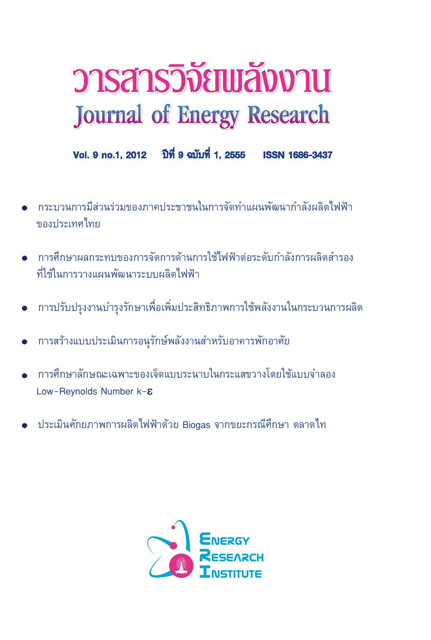การศึกษาลักษณะเฉพาะของเจ็ตแบบระนาบในกระแสขวางโดยใช้แบบจำลอง Low-Reynolds Number k-epsilon
Main Article Content
Abstract
บทความนี้นำเสนอการใช้ระเบียบวิธีไฟไนต์วอลุมเพื่อคำนวณการไหลแบบปั่นป่วนของเจ็ตแบบระนาบสองมิติในกระแสขวาง โดยมีวัตถุประสงค์เพื่อจำลองรูปแบบการระบายอากาศทั้งการเปลี่ยนแปลงของอุณหภูมิและรูปแบบการไหลที่มีผลต่อพลังงานความร้อน การฟุ้งกระจายของฝุ่นหรือสสารจากเจ็ตแบบระนาบ ซึ่งสามารถพิจารณาในรูปสองมิติได้ โดยพิจารณาจากวิถีการเคลื่อนที่ของเจ็ต (Jet trajectory) และความเข้มข้นของปริมาณสเกลาร์ (Scalar concentration) ซึ่งใช้เป็นตัวแทนของความเข้มข้นโดยมวลหรืออุณหภูมิ โดยแบบจำลองความปั่นป่วนที่เลือกใช้คือ แบบจำลอง Standard k-epsilon และ Low-Reynolds number k-epsilon โดยมีพารามิเตอร์ที่พิจารณาคือ อัตราส่วนความเร็วของกระแสเจ็ตต่อกระแสขวาง (R) ทั้งในส่วนที่ค่า R < 1 และค่า R > 1 ผลลัพธ์ที่ได้จากโปรแกรมคอมพิวเตอร์ชี้ให้ เห็นว่า ค่า R ที่เพิ่มขึ้นทำให้เกิดการกระจายตัวที่เพิ่มขึ้นของปริมาณสเกลาร์ด้านหลังทางออกเจ็ต นอกจากนี้รัศมีความโค้งของวิถีการเคลื่อนที่ของเจ็ตและเส้นศูนย์กลางการเคลื่อนที่ของปริมาณสเกลาร์ก็เพิ่มขึ้นเช่นกัน ในกรณีที่ค่า R > 1 ปริมาณสเกลาร์สามารถกระจายตัวได้กว้างตามขนาดการไหลวน แต่ปริมาณสเกลาร์ที่มีค่าสูงยังคงอยู่ใกล้กับปากทางออกของเจ็ต ในขณะที่กรณีค่า R < 1 ปริมาณสเกลาร์ที่มีค่าสูงจะเคลื่อนที่ได้ไกลกว่าถึงแม้ว่าการกระจายตัวจะอยู่ในบริเวณใกล้เคียงกับผนังด้านล่าง ในส่วนของแบบจำลองความปั่นป่วนจะเห็นได้ว่าแบบจำลอง Low-Reynolds number k-epsilon สามารถทำนายขนาดการไหลวนและการเปลี่ยนแปลงบริเวณใกล้ผนังได้ดีกว่าแบบจำลอง
Standard k-epsilon A Study of Plane Jet Characteristics in Crossflow via Low-Reynolds Number k-epsilon Model
Rungroj Watjiranont and Sompong Putivisutisak
Department of Mechanical Engineering, Chulalongkorn University, Bangkok, Thailand 10330
This article presents a finite volume method for prediction of turbulent plane jet in crossflow. The purpose is to numerically simulate two-dimensional air ventilation and heat dissipation of the jet. The results are present by the flow or substance dissipation patterns which can be determined by considering the jet trajectory, scalar concentration and flow behavior around the jet exit. The Standard k-epsilon and Low-Reynolds number k-epsilon models are utilized here. The primary parameter is the jet to cross-stream velocity ratios (R) in two specific ranges i.e. R < 1 and R > 1 . The results from the computer program indicate that, when the velocity ratio, R increases, the scalar dissipation behind the jet exit increases. Furthermore, the radii of jet trajectory and scalar centerline trajectory also increase with the increasing velocity ratio. For R > 1 , the scalar concentration yields large dissipation with the high values dissipating nearby the jet exit. When R < 1 , the high scalar concentration dissipates close to the bottom wall and further away from the jet exit because of the crossflow influence. It can be seen that the Low-Reynolds number k-epsilon model is able to predict the recirculation and near wall effect better than the standard k-epsilon model.

